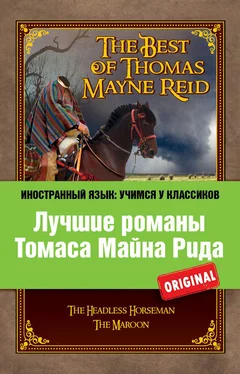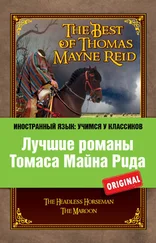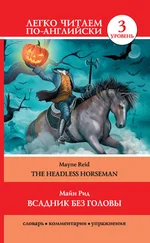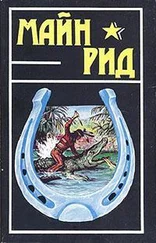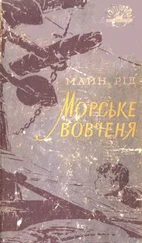Her turning aside from the Jumbé Rock could not have been from fear: for the direction she was now following would carry her to a place equally dreaded by the superstitious – the Duppy’s Hole.
That she was proceeding to this place was evident. There was no distinct path leading thither, but the directness of her course, and the confidence with which she kept it, told that she must have gone over the ground before.
Forcing her way through the tangle of vines and branches, she strode courageously onward – until at length she arrived on the edge of the cliff that hemmed in the cavernous hollow.
The point where she reached it was just above the gorge – the place where the tree stairway led down to the lagoon.
From her actions, it was evident that the way was known to her; and that she meditated a descent into the bottom of the valley.
That she knew she could accomplish this feat of herself, and expected some one to come to her assistance, was also evident from her proceeding to make a signal as soon as she arrived upon the edge of the cliff.
Drawing from the bosom of her dress a small white kerchief, she spread it open upon the branch of a tree that grew conspicuously over the precipice; and then, resting her hand against the trunk, she stood gazing with a fixed and earnest look upon the water below.
In the twilight, now fast-darkening down, even the white kerchief might have remained unnoticed. The woman, however, appeared to have no apprehension upon this head. Her gaze was expectant and full of confidence: as if the signal had been a preconcerted one, and she was conscious that the individual for whom it was intended would be on the look-out.
Forewarned or not, she was not disappointed. Scarce five minutes had transpired from the hanging out of the handkerchief, when a canoe [540] was seen shooting out from under the moss-garnished trees that fringed the upper edge of the lagoon, and making for the bottom of the cliff beneath the spot where she stood.
A single individual occupied the canoe; who, even under the sombre shadow of the twilight, appeared to be a man of dread aspect.
He was a negro of gigantic size; though that might not have appeared as he sat squatted in the canoe but for the extreme breadth of his shoulders, between which was set a huge head, almost neckless. His back was bent like a bow, presenting an enormous hunch – partly the effect of advanced age, and partly from natural malformation. His attitude in the canoe gave him a double stoop: so that, as he leant forward to the paddle, his face was turned downward, as if he was regarding some object in the bottom of the craft. His long, ape-like arms enabled him to reach over the gunwale without bending much to either side; and only with these did he appear to make any exertion – his body remaining perfectly immobile.
The dress of this individual was at the same time grotesque and savage. The only part of it which belonged to civilised fashion was a pair of wide trousers or drawers, of coarse Osnaburgh linen – such as are worn by the field hands on a sugar plantation. Their dirty yellowish hue told that they had long been strangers to the laundry: while several crimson-coloured blotches upon them proclaimed that their last wetting had been with blood, not water.
A sort of kaross , or cloak, made out of the skins of the utia , and hung over his shoulders, was the only other garment he wore. This, fastened round his thick, short neck by a piece of leathern thong, covered the whole of his body down to the hams – the Osnaburgh drawers continuing the costume thence to his ankles.
His feet were bare. Nor needed they any protection from shoes – the soles being thickly covered with a horn-like callosity, which extended from the ball of the great toe to the broad heel, far protruding backward.
The head-dress was equally bizarre . It was a sort of cap, constructed out of the skin of some wild animal; and fitting closely, exhibited, in all its phrenological [541] fulness, the huge negro cranium which it covered. There was no brim; but, in its place, the dried and stuffed skin of the great yellow snake was wreathed around the temples – with the head of the reptile in front, and two sparkling pebbles set in the sockets of its eyes to give it the appearance of life!
The countenance of the negro did not need this terrific adornment to inspire those who beheld it with fear. The sullen glare of his deep-set eye balls; the broad, gaping nostrils; the teeth, filed to a point, and gleaming, sharklike, behind his purple lips; the red tattooing upon his cheeks and broad breast – the latter exposed by the action of his arms – all combined in making a picture that needed no reptiliform addition to render it hideous enough for the most horrid of purposes. It seemed to terrify even the wild denizens of the Duppy’s Hole. The heron, couching in the sedge, flapped up with an affrighted cry; and the flamingo, spreading her scarlet wings, rose screaming over the cliffs, and flew far away.
Even the woman who awaited him – hold as she may have been, and voluntary as her rendezvous appeared to be – could not help shuddering as the canoe drew near; and for a moment she appeared irresolute, as to whether she should trust herself in such uncanny company.
Her resolution, however, stimulated by some strong passion, soon returned; and as the canoe swept in among the bushes at the bottom of the cliff, and she heard the voice of its occupant summoning her to descend, she plucked the signal from the tree, fixed the basket firmly over her arm, and commenced letting herself down through the tangle of branches.
The canoe re-appeared upon the open water, returning across the lagoon. The mulatta woman was seated in the stern, the man, as before, plying the paddle, but now exerting all his strength to prevent the light craft from being carried down by the current, that could be heard hissing and groaning through the gorge below.
On getting back under the tree from which he had started, the negro corded the canoe to one of the branches; and then, scrambling upon shore, followed by the woman, he walked on towards the temple of Obi – of which he was himself both oracle [542] and priest.
Chapter 21
The Resurrection
Arrived at the cotton-tree hut, the myal-man – for such was the negro – dived at once into the open door, his broad and hunched shoulders scarce clearing the aperture.
In a tone rather of command than request he directed the woman to enter.
The mulatta appeared to hesitate. Inside, the place was dark as Erebus: though without it was not very different. The shadow of the ceiba , with its dense shrouding of moss, interrupted every ray of the moonlight now glistening among the tops of the trees.
The negro noticed her hesitation.
“Come in!” cried he, repeating his command in the same gruff voice. “You me sabbey – what fo’ you fear?”
“I’se not afraid, Chakra,” replied the woman, though the trembling of her voice contradicted the assertion; “only,” she added, still hesitating, “it’s so dark in there.”
“Well, den – you ’tay outside,” said the other, relenting; “you ’tay dar wha you is; a soon ’trike a light.”
A fumbling was heard, and then the chink of steel against flint, followed by fiery sparks.
A piece of punk was set a-blaze, and from this the flame was communicated to a sort of lamp, composed of the carapace of a turtle, filled with wild-hog’s lard, and having a wick twisted out of the down of the cotton-tree.
“Now you come in, Cynthy,” resumed the negro, placing the lamp upon the floor. “Wha! you ’till afeard! You de dauter ob Juno Vagh’n – you modder no fear ole Chakra. Whugh! she no fear de Debbil!”
Cynthia, thus addressed, might have thought that between the dread of these two personages there was not much to choose: for the Devil himself could hardly have appeared in more hideous guise than the human being who stood before her.
Читать дальше
Конец ознакомительного отрывка
Купить книгу
